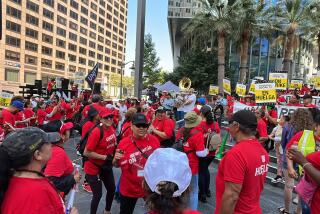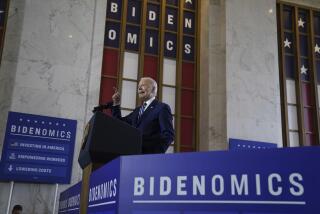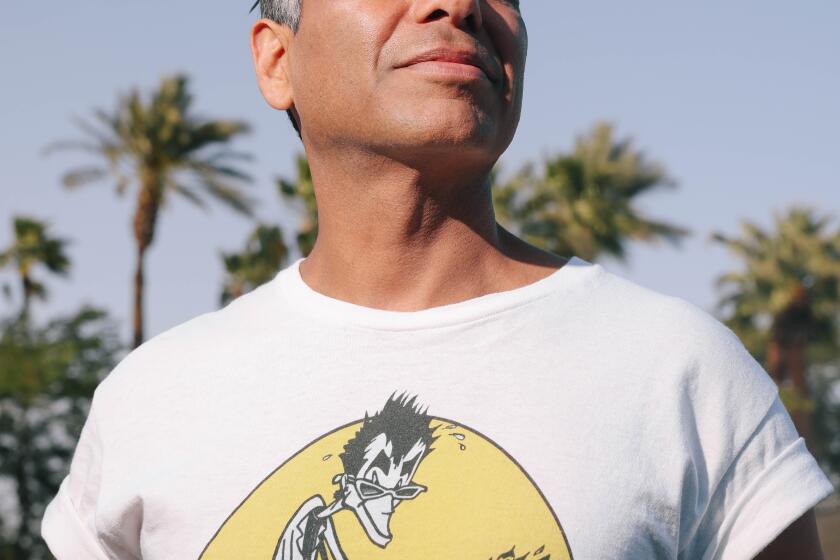Book review: ‘The New Deal: A Modern History’
The New Deal
A Modern History
Michael Hiltzik
Free Press: 499 pp., $30
Michael Hiltzik’s “Colossus,” published last year, told the story of the building of what is now known as the Hoover Dam, an epic public works project that was seized upon by President Franklin Delano Roosevelt as an icon of his New Deal. Hiltzik’s latest, an extension of “Colossus” in a way, moves on to the subject of the New Deal itself, beginning with FDR’s election in November 1932 and his inauguration four months later on a cold, damp day when America, in the midst of a banking collapse, was a “stupefied giant standing face to face with insolvency.” The subject could scarcely be more pertinent or timely.
FDR’s road map to economic recovery centered upon a plethora of government-backed job creation programs and actual money relief for those who were flat on their backs. A Times business columnist and winner of a Pulitzer Prize, Hiltzik shows how these various programs developed, changed and grew over the years leading up to World War II. He gives us the tales of the legislation, the strikes, the crises. We get the Dust Bowl and the dams and federally funded radical arts projects too. The sweep is wide, but then it needs to be, even if all this lacks the narrative spine that so propels “Colossus.” “The New Deal effectively ended in 1939, amid doubts about Roosevelt’s leadership and under the shadow of war, as a work in progress,” Hiltzik writes. “To a great extent it is still unfinished.”
Hiltzik is keen to show that FDR’s response to the hardest of times had a grabby, improvisational quality, especially during his first years in office. There was no existing blueprint: FDR wasn’t inherently progressive but flexible and pragmatic, he argues, understanding that “politics were less often about substance than presentation and that audiences always were less bothered by paradox than they were impressed by self-confidence.” The New Deal wasn’t at first a vision but a system of evolving strategies that were pursued or discarded. Only gradually was there a transition from an impromptu series of experiments to a calculated, overarching plan.
FDR did what it took, and he did it with a team, and during much of Hiltzik’s “The New Deal,” FDR himself is a figure in the background. Instead, Hiltzik focuses on the key collaborators. Among them: Frances Perkins, secretary of Labor and the architect of Social Security; Gen. Hugh S. Johnson, head of the National Recovery Administration (NRA); Harold Ickes, head of the Works Progress Administration (WPA); Harold Hopkins, head of the Federal Emergency Relief Administration (FERA).
The New Deal had more acronyms than a James Bond novel and behind each was a huge personality.
“Johnson was a shouter, a table-pounder, a West Point man with a conspicuous gift for vivid and vitriolic expression that had not been heard in the mainstream of American politics within living memory,” Hiltzik writes. Perkins, on trying to take up her new position, found herself more or less locked out of a building that was like something out of Kafka, staffed by shadowy, resentful underlings who were even more threatening than the cockroaches that leaped from the woodwork.
Ickes and Hopkins, who would remain two of FDR’s most loyal and trusted aides, couldn’t stand the sight of each other. The author nails this rivalrous enmity with amused aplomb. Ickes pinched on every penny; Hopkins liked to shovel out each dime as fast as it came in. “The roots of their conflict lay in the personalities of the two men — Hopkins given to confident self-righteousness, Ickes to paranoia — and in their irreconcilably low opinions of each other’s skills as relief organizers. To Ickes, Hopkins was a spendthrift whose program amounted to “thousands of make-believe projects in all parts of the country.” Hopkins disdained Ickes’ taste for projects of monumental permanence in which most of the spending went “for materials, not men.”
The court of King Franklin was, indeed, replete with shakers and movers busily trying to stab one another in the back. The young advisor to FDR, Thomas Corcoran, “Tommy the Cork,” rises as a “master legislative craftsman” but then puts himself into eclipse. Felix Frankfurter, Corcoran’s mentor, makes a comeback. And so on. Clever FDR wooed them all with charm, firing them — as he did Johnson, the table-thumping titan — if their political shelf lives had reached their sell-by date. Hiltzik gives a thrilling sense of this, the sweaty, seamy personal side of politics, and he conveys, too, one of history’s fundamental mysteries and fascinations, namely, that momentous decisions are usually made behind closed doors by a small number of people who leave self-serving contradictory accounts of what occurred.
In “The New Deal” FDR emerges as an elusive figure, unwilling to be pinned down and endlessly adaptive. A politician, in other words, and Hiltzik does successfully show the extent to which the various provisions of the New Deal were a non-ideological improvisation, hectic, driven, often fizzling and failing. Yet the big picture effects were swift and direct: 11.5 million people were unemployed in 1932; 6.2 million at the end of 1938. Jobs were key.
“The WPA produced, among many other projects, one thousand miles of new and rebuilt airport runways, 651,000 miles of highway, 124,000 bridges, 8,000 parks, and 18,000 playgrounds and athletic fields; some 84,000 miles of drainage pipes, 69,000 highway light standards, and 125,000 public buildings built, rebuilt, or expanded. Among the latter were 41,300 schools,” Hiltzik records. “The transformative power of this effort is inestimable.”
The New Deal’s vast legacies are still with us, and so, too, are the questions it provoked. “Was it a success or failure? The plot of a dictator? A paragon of progressive government or a harbinger of oppressive federal interference in American life?” Hiltzik asks.
FDR , while appreciating that banking ethics are a movable feast, established systems to curb the excesses of Wall Street and was persistently attacked by hysterical critics. The parallels with Barack Obama are close, as Hiltzik notes: “Yet both Presidents appear to have shared a conviction that their task was not to dismantle the American capitalist system, but to save it from its excesses.”
FDR’s nimble porousness turned him into a presidential survivor: He spoke of fearlessness and hope and a better future, and he delivered enough. Hiltzik’s wide-ranging book reveals the intricacies of how.
Rayner’s recent books include “A Bright and Guilty Place: Murder, Corruption, and L.A.’s Scandalous Coming of Age” and “The Associates: Four Capitalists Who Created California.”
More to Read
The biggest entertainment stories
Get our big stories about Hollywood, film, television, music, arts, culture and more right in your inbox as soon as they publish.
You may occasionally receive promotional content from the Los Angeles Times.






